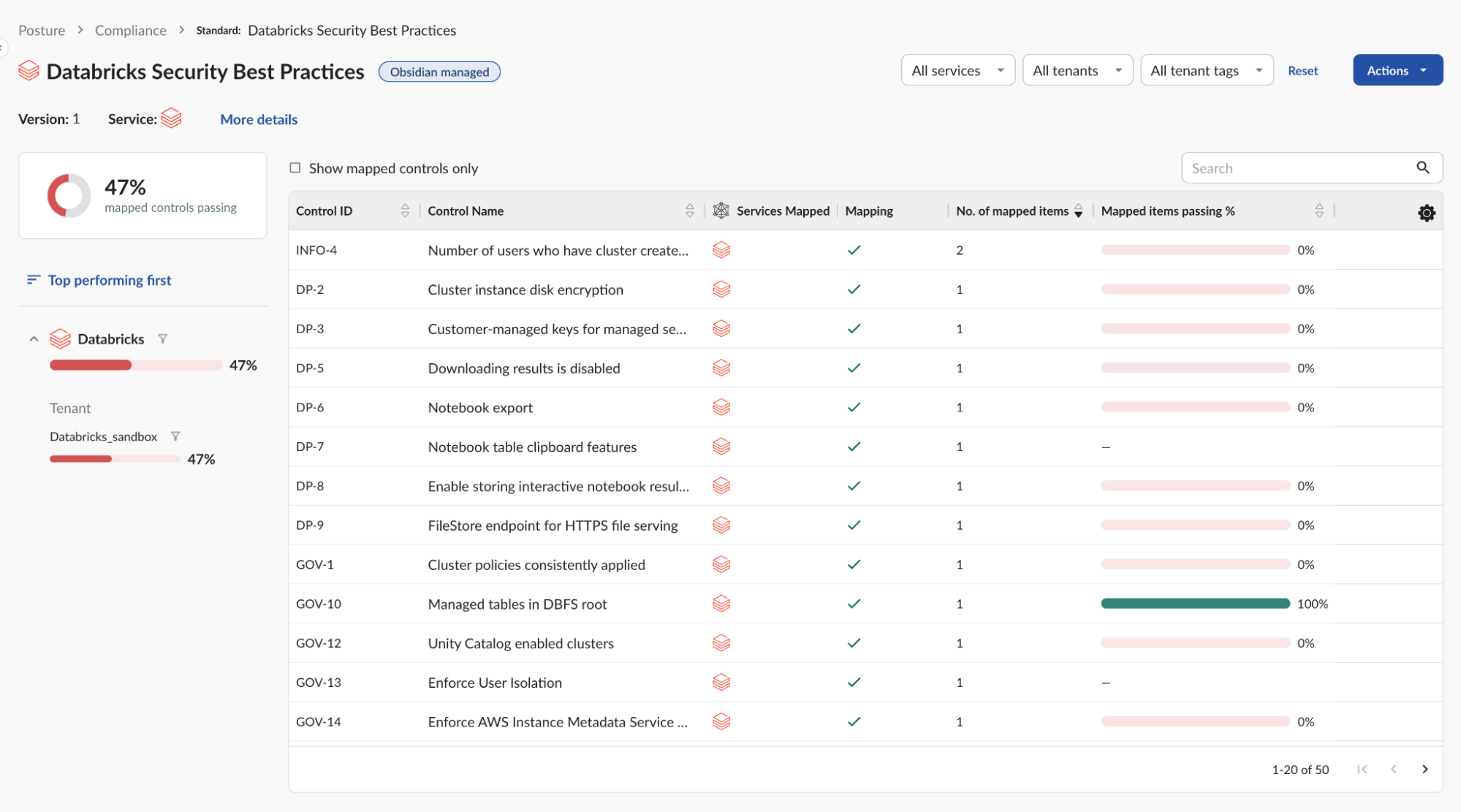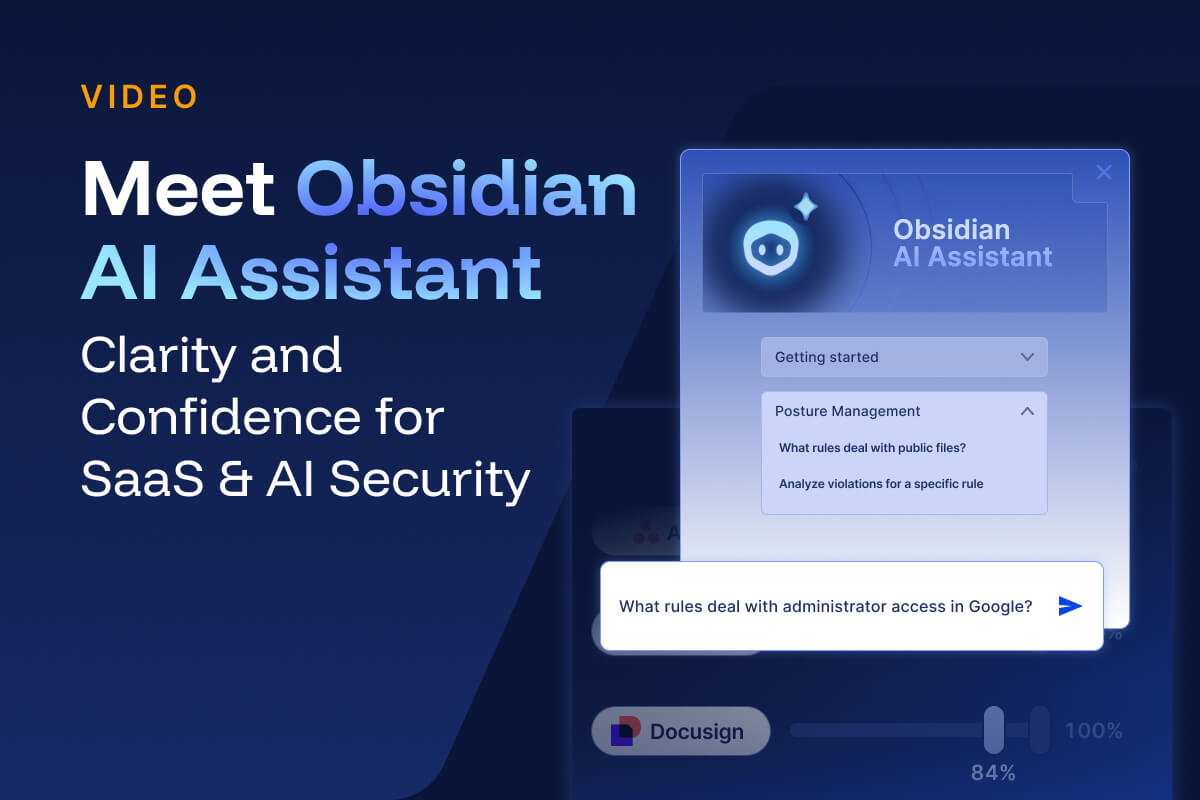At Obsidian Security, we’re proud to be a launch partner for Databricks’ Data Intelligence for Cybersecurity. This partnership equips security teams with the tools and expertise to strengthen Databricks deployments and confidently accelerate AI adoption on the platform.
Companies race to adopt AI, with Databricks leading the transformation for data intelligence. To boost productivity, organizations use autonomous agents for process optimization, but this rapid adoption also brings identity, integration, and SaaS supply chain risks. Obsidian secures Databricks by safeguarding agents, automating posture hardening, detecting identity threats, and monitoring integrations, so businesses can scale AI without slowing innovation.
Immediate Out-of-the-Box Compliance, Without Slowing Innovation
Obsidian’s solution delivers the granular visibility needed to monitor and protect every user and agent interacting with Databricks, ensuring comprehensive security. By mapping natively to the Databricks AI Security Framework (DASF), Obsidian provides out-of-the-box alignment with governance requirements, reduces audit complexity, and ensures organizations can innovate with confidence, all without compromising compliance.
Databricks’ platform empowers organizations with unmatched flexibility, speed, and scale. But with that power comes a challenge: ensuring security and compliance without slowing innovation. Third-party AI and integration threats, expanding regulatory demands, and the limitations of manual controls make it difficult for enterprises to balance data access with risk management.
That’s where Obsidian comes in. We extend Databricks’ security capabilities with posture management, integration oversight, and threat detection, helping you achieve 360° protection across posture, integrations, and threats.
From Insights to Action: Automating Security Posture with Databricks SAT
Databricks provides strong foundational tools, and Obsidian helps enforce them. Our platform ensures your environment aligns with industry standards and best practices by:
- Automating access governance and workspace privileges.
- Operationalizing recommendations from Databricks’ Security Analysis Tool (SAT).
- Mapping controls to NIST and custom compliance frameworks.
- Simplifying workflows for continuous compliance.
With Obsidian, organizations move beyond point-in-time checks to achieve continuous posture hardening.

Breaking Silos: Unified Security Data and Control in Databricks
The SaaS supply chain comprises the network of applications, vendors, and services an organization uses for daily business operations. One critical part of this network is third-party integrations, which are also a growing source of risk: the recent Salesloft supply chain breach revealed that supply chain breaches are 10x more damaging than traditional credential-based breaches. Connected SaaS apps and AI/LLM vendors can inadvertently expose sensitive data if left unchecked.
Obsidian provides complete visibility and context into Databricks integrations to help you:
- Inventory all first- and third-party connections.
- Flag overly permissive or misconfigured integrations that create unnecessary risk exposure across your external vendor chain.
- Detect and mitigate risky external data flow, effectively isolating compromised links to prevent widespread data leakage.
On average, customers see an 80% reduction in third-party integration risk with Obsidian.

Continuous Identity Defense for Databricks SaaS App
Identity-based threats remain one of the most common and costly attack vectors. Obsidian continuously monitors user behavior to detect threats early and reduce risk by:
- Profiling logins and audit activity to detect compromised accounts.
- Identifying and removing dormant privileged accounts.
- Combining Databricks Unity Catalog insights with HR and IdP data to reveal risky access patterns.
With these capabilities, customers achieve sub-1-hour detection times for identity threats.

Unlock Faster, Safer AI Adoption with Databricks and Obsidian
Databricks provides the scale and intelligence, Obsidian provides the identity, integration, and SaaS security expertise. With the Obsidian Delta Sharing Connector, security teams gain deeper context to accelerate investigations and cut detection and response times from days to hours.
Together, Obsidian and Databricks provide a unified, secure data platform that enables seamless integration and analysis. The joint solution delivers continuous monitoring of posture, integrations, and identity risks, while Obsidian’s Databricks-native workflows eliminate redundant processing to reduce SIEM costs.
With a single, enriched view of identities and activities across SaaS and PaaS applications, security teams can stop chasing fragmented logs and instead focus on protecting data, enabling safe AI adoption, and responding faster when threats emerge.
Learn more at Obsidian’s marketplace listing or book a demo here.




